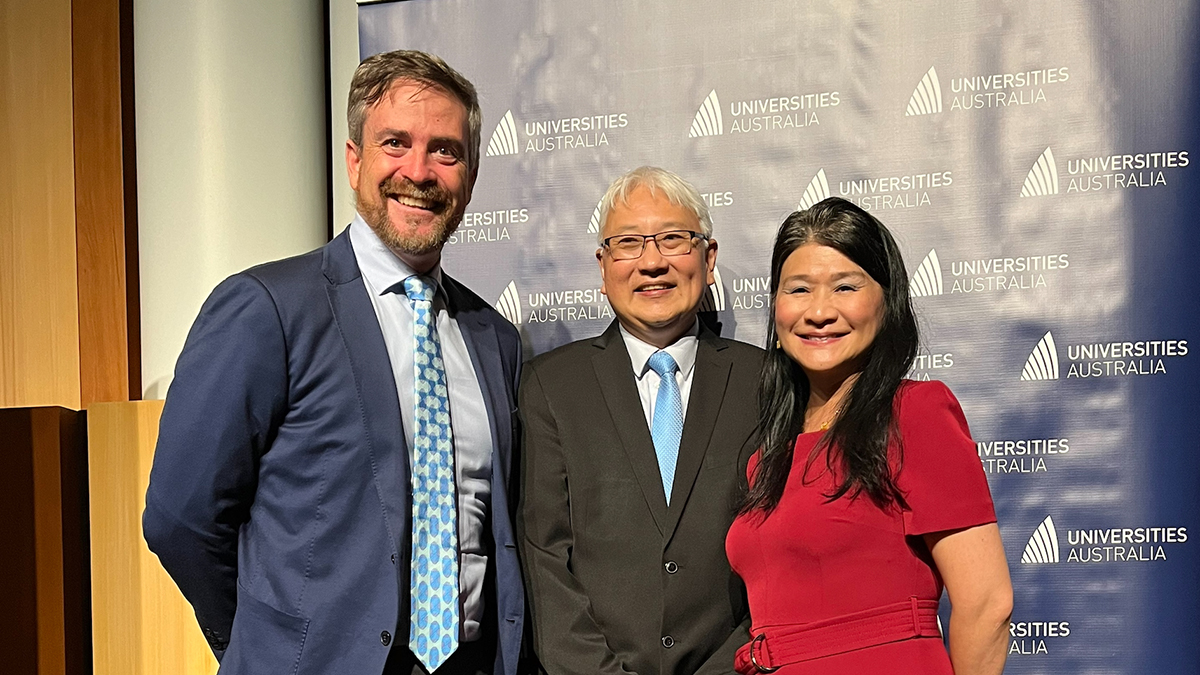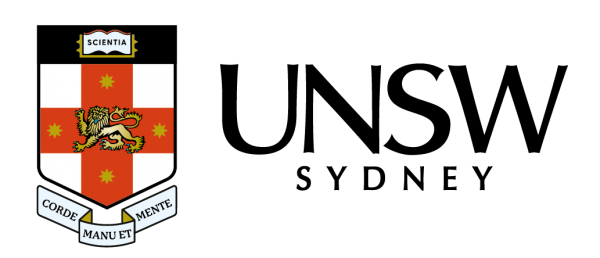
Dear colleagues
Last week I attended the Universities Australia ‘Solutions Summit’ with colleagues from UNSW and across the higher education sector. It was an opportunity to discuss opportunities for the sector and how universities can work together, along with government and industry, to address some of Australia’s most pressing societal issues. One of the highlights was the inaugural Shaping Australia Awards, which recognise outstanding contributions from Australian universities and their partners that are helping to make Australia better, including contributions by UNSW researchers.
It was wonderful to see Professor Guan Yeoh (pictured above with his wife Natalie Lim) acknowledged at the awards for his trailblazing work in fire protection technologies. Guan and his team won the People’s Choice Award in the Problem Solver category for their innovative fire-retardant paint which protects homes from the impact of bushfires. It has the potential to change countless Australians’ lives and exemplifies UNSW’s vision to have a positive impact on our community – you can buy it at Bunnings today (I’ve already ordered some for relatives who have lived through a number of bushfires). Visit the Newsroom to read more about this outstanding work and other UNSW innovators recognised in the awards.
The release of the Universities Accord coincided with the conference, which, as I’m sure you can imagine, influenced much of the conversation. The Accord includes 29 findings and 47 recommendations. At the centre of the Accord is a recognition of the critical role played by universities and the tertiary sector in the prosperity and wellbeing of Australians.
The importance of education for the future of Australia underpins the ambition in the Accord of 80 per cent of Australians having some form of traditional or non-traditional tertiary qualification by 2050, and the reaffirmation that access to higher education must be equitable. However, as we work to increase access to a university education, it is critical that student success is placed as an equally important goal – to ensure that students from under-represented backgrounds don’t just enrol, but also graduate and find meaningful employment. The success of the Accord now lies with how government responds to these recommendations, and which of them it chooses to prioritise and fund.
You can read some of my thoughts about the Accord published in The Australian online last Thursday. UNSW is still reflecting on the implications of the Accord, but we look forward to working with government to ensure a higher education system that prepares Australia and Australians for the future.
Nura Gili celebrates 20th anniversary
It was a pleasure to be part of an event last month marking the 20th anniversary of Nura Gili and celebrating the extraordinary achievements of UNSW’s Indigenous alumni community.
Nura Gili Centre for Indigenous Programs is the central hub of Indigenous education at UNSW. For two decades services, programs and staff at Nura Gili have been central to creating an environment in which Aboriginal and Torres Strait Islander students can thrive.
Nura Gili has played an important role in driving UNSW’s Indigenous strategy, and in providing support to help students succeed while they are at university and beyond.
Supercomputing Asia conference
I had the privilege of opening the recent Supercomputing Asia Conference, with the theme Exascale readiness in AI, HPC and Quantum. The conference brought together international experts to explore how the enormous potential of exascale computing could be realised to address critically important scientific challenges like climate change, environmental sustainability, medicine and healthcare.
State-of-the-art Diraq Lab opens at UNSW
Later that day, I was also privileged to be part of the UNSW ceremony which opened the state-of-the-art Diraq Lab. Diraq is a staff spinout that puts the University at the forefront of quantum computing research. Although incorporated less than two years ago, we have been on a journey with Diraq for more than two decades. The silicon quantum dot technology that is at Diraq’s core – known as “electron spins in CMOS quantum dots” – was invented right here on campus, leveraging more than 20 years of engineering and research expertise.
The opening of the Diraq Lab is another strong step forward. Diraq Founder and CEO, Scientia Professor Andrew Dzurak and the team of brilliant engineers, researchers, partners and investors are among those leading the charge in the bold mission of delivering revolutionary quantum computing technology to the world.
Australia’s gender pay gap data published
The Workplace Gender Equality Agency (WGEA) has published base salary and total remuneration median gender pay gaps for private sector employers in Australia with 100 or more employees, revealing a national gender pay gap of 19 per cent. UNSW reported a median gender pay gap of 1.4 per cent, the smallest total remuneration gender gap among the Go8 and a positive result at a national, industry and organisational level.
Gender pay equity is critical to a healthy society and an inclusive culture. WGEA’s publication of this data is a very useful tool, providing transparency for all. UNSW has worked hard to put in place strategies to close the gender pay gap and to keep it closed. However, while I’m pleased about where we stand based on this data, we cannot be complacent. We need to continue to progress. The headline results mask heterogeneity of performance throughout the University so we must continue to take meaningful action to ensure pay and opportunities are equitable at UNSW.
There’s even more to read Inside UNSW…
- Last week we welcomed Associate Professor Brett Biles to the role of inaugural Pro Vice-Chancellor Indigenous Engagement and Research.
- UNSW climate data expert Professor Lisa Alexander has been awarded the prestigious Copernicus Medal for her innovative climate change research. Congratulations Lisa!
- This edition of Inside UNSW features another fascinating staff profile – urban climatologist and outrigger rower Dr Negin Nazarian.
- UNSW is developing its first Societal Impact Framework and we want to hear your thoughts. If you haven’t been able to get to one of the consultation sessions, you can take part in the Societal Impact Survey.
Best regards
Attila
Professor Attila Brungs
Vice-Chancellor and President
- Log in to post comments
